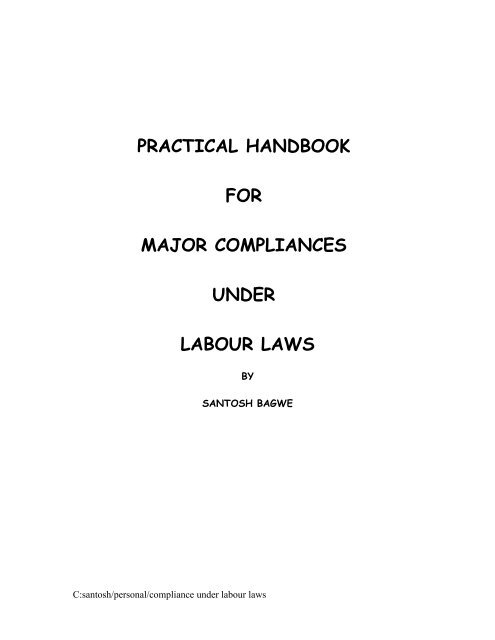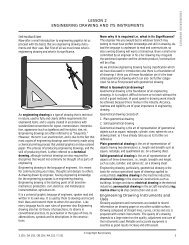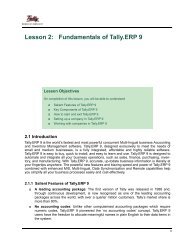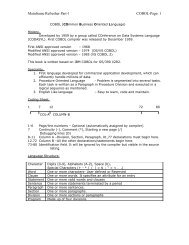practical handbook for major compliances under labour laws - Cifo
practical handbook for major compliances under labour laws - Cifo
practical handbook for major compliances under labour laws - Cifo
You also want an ePaper? Increase the reach of your titles
YUMPU automatically turns print PDFs into web optimized ePapers that Google loves.
PRACTICAL HANDBOOK<br />
FOR<br />
MAJOR COMPLIANCES<br />
UNDER<br />
LABOUR LAWS<br />
BY<br />
SANTOSH BAGWE<br />
C:santosh/personal/compliance <strong>under</strong> <strong>labour</strong> <strong>laws</strong>
COMPLIANCES UNDER LABOUR LAWS<br />
INDEX<br />
Sr. No. Particulars<br />
1 The Apprentices Act,1961<br />
2 The Contract Labour (Regulation & Abolition) Act, 1970<br />
3 The Employee’s Provident Fund & Miscellaneous Provisions Act, 1952<br />
4 The Employees’ State Insurance Act, 1948<br />
5 The Employment Exchanges (Compulsory notification of vacancies)<br />
Act, 1959<br />
6 The Equal Remuneration Act, 1976<br />
7 The Factories Act, 1948<br />
8 The Indian Fatal Accidents Act, 1985<br />
9 The Industrial Dispute Act, 1947<br />
10 The Industrial Employment (Standing Orders) Act, 1946<br />
11 The Maternity Benefit Act, 1961<br />
12 The Minimum Wages Act, 1948<br />
13 The Payment of Bonus Act, 1965<br />
14 The Payment of Gratuity Act, 1972<br />
15 The Payment of Wages Act, 1936<br />
16 The Workmen’s Compensation Act, 1923<br />
C:santosh/personal/compliance <strong>under</strong> <strong>labour</strong> <strong>laws</strong>
APPROPRIATION OF LABOUR LAWS<br />
Broadly Labour <strong>laws</strong> can be appropriated as <strong>under</strong>:<br />
1) Labour <strong>laws</strong> related to welfare measures<br />
2) Labour <strong>laws</strong> related to payroll<br />
3) Labour <strong>laws</strong> related to administration<br />
4) Labour <strong>laws</strong> related to social measures<br />
5) Labour <strong>laws</strong> related to fire-fighting role of Personnel and HR Manager<br />
C:santosh/personal/compliance <strong>under</strong> <strong>labour</strong> <strong>laws</strong>
Labour Laws relating to welfare measures<br />
Sr. No. Particulars<br />
1 The Employee’s Provident Fund & Miscellaneous Provisions Act, 1952<br />
2 The Employees’ State Insurance Act, 1948<br />
3 The Maternity Benefit Act, 1961<br />
4 The Payment of Gratuity Act, 1972<br />
5 The Workmen’s Compensation Act, 1923<br />
Labour Laws relating to payroll<br />
Sr. No. Particulars<br />
1 The Equal Remuneration Act, 1976<br />
2 The Minimum Wages Act, 1948<br />
3 The Payment of Bonus Act, 1965<br />
4 The Payment of Wages Act, 1936<br />
Labour Laws relating to administration<br />
Sr. No. Particulars<br />
1 The Factories Act, 1948<br />
2 The Indian Fatal Accidents Act, 1985<br />
C:santosh/personal/compliance <strong>under</strong> <strong>labour</strong> <strong>laws</strong>
Labour Laws relating to Social Measures<br />
Sr. No. Particulars<br />
1 The Apprentices Act,1961<br />
2 The Contract Labour (Regulation & Abolition) Act, 1970<br />
3 The Employment Exchanges (Compulsory Notification of Vacancies)<br />
Act, 1959<br />
Labour Laws relating to fire fighting role of Personnel and HR Manager<br />
Sr. No. Particulars<br />
1 The Industrial Dispute Act,<br />
2 The Industrial Employment (Standing Orders) Act, 1946<br />
C:santosh/personal/compliance <strong>under</strong> <strong>labour</strong> <strong>laws</strong>
The Apprentices Act, 1961<br />
Applicability: It is a statutory obligation of every industry/establishment having<br />
training facilities according to syllabus in a designated trade <strong>under</strong> the<br />
Apprentices Act, 1961 to train a number of apprentices according to ratio of<br />
the trade in their establishment.<br />
Major Compliance:<br />
1) General Obligations:<br />
a) To provide the apprentice with training in his trade in accordance<br />
with Act and rules.<br />
b) To ensure that a qualified person is placed in charge of the training.<br />
c) To carry out obligation <strong>under</strong> the contract.<br />
2) Registration of contract of apprenticeship:<br />
To send the apprenticeship advisor the contract of apprenticeship within 3<br />
months of date on which it was signed.<br />
3) Payment to apprentice:<br />
To pay to every apprentice during the period of apprenticeship such stipend<br />
at a rate prescribed <strong>under</strong> the Act.<br />
4) Working hours <strong>for</strong> apprentice:<br />
a) Total number of hour: 42 to 48 hours per week.<br />
b) Trade apprentice <strong>under</strong>going basic training: 42 hours.<br />
c) Trade apprentice <strong>under</strong>going 2 nd year: 42 to 45 hours.<br />
d) Trade apprentice <strong>under</strong>going 3 rd and subsequent years: As per the<br />
workers in the trade in the same establishment.<br />
e) No trade apprentice shall be engaged between the hours of 10 p.m. to<br />
5 p.m. without the permission of Apprenticeship Advisor.<br />
f) Graduate or technician apprentice: Normal hours of work of the dept.<br />
5) Health, welfare and safety of apprentice: as per Factories Act.<br />
6) Compensation <strong>for</strong> injury: as per Workmen Compensation Act.<br />
7) Compensation <strong>for</strong> termination of apprenticeship: 6 months’ last drawn<br />
stipend by both parties<br />
Note: Apprentices advisors (Inspector) – Labour Minister – Sion Chunabbhati opp.<br />
Priyadarshani Bldg in Mumbai.<br />
C:santosh/personal/compliance <strong>under</strong> <strong>labour</strong> <strong>laws</strong>
The Contract Labour (Regulation & Abolition) Act, 1970<br />
Applicability:<br />
Applicable to: 1) every establishment in which 20 or more workmen are employed or<br />
were employed on any day of the preceding twelve months as<br />
contract <strong>labour</strong>.<br />
2) every contractor who employs or who employed on any day of the<br />
preceding twelve months twenty or more workman.<br />
Not applicable to: Establishment which carry on work of a casual nature<br />
occasionally.<br />
Effect of non-registration: The principal employer cannot employ contract <strong>labour</strong><br />
in establishment.<br />
Major Compliance:<br />
1) It is obligatory on every contractor not to <strong>under</strong>take or execute any work<br />
through contract <strong>labour</strong> without obtaining a valid licence from the licencing<br />
officer.<br />
2) Obligation to provide certain amenities:<br />
A) Provision of canteens<br />
B) Rest Rooms<br />
C) Drinking water and other facilities like latrines and urinals<br />
D) First-aid facilities<br />
E) Creaches<br />
3) It is obligatory on principal employer to see that wages of the workers are<br />
paid every month on a fixed date and time and on termination of their<br />
employment be<strong>for</strong>e the expiry of 2 nd working day after termination.<br />
Maintenance of Records:<br />
Form No. XXIV Half yearly Return in duplicate within 30 days by contractor<br />
Register Particulars<br />
Form No. XII Register of Contractor - Maintained by Principal employer <strong>for</strong><br />
each establishment<br />
Form No. XIII Maintained by Contractor <strong>for</strong> each establishment<br />
Form No. XIV Contractor to issue an employment card to each worker within 3<br />
days of employment<br />
Form No. XV A service certificate in case of termination of wokman<br />
XVI-A muster roll, XVII-Register of wages, XX-deduction <strong>for</strong> damange, XXI –<br />
Register of fines, XXII- Register of advances, XXIII-Register of overtime<br />
C:santosh/personal/compliance <strong>under</strong> <strong>labour</strong> <strong>laws</strong>
Notes: Company has to register every year<br />
1) In a year <strong>labour</strong> should not work above 240 workig days<br />
2) Every 80 days employer should break <strong>labour</strong> service – need to update every<br />
80 days with the contractor<br />
3) Contractor should pay minimum wages to the <strong>labour</strong><br />
Documents require:<br />
1) License with the contractor & registration of the company<br />
2) Contractor – PF no., ESIC no.,<br />
Offices of Labour Laws in Mumbai:<br />
1) Mumbai – Labour office is at Tardeo – AC Market<br />
2) Thane – Makhmali Talav<br />
3) New Mumbai – Khanda Colony - Panvel<br />
C:santosh/personal/compliance <strong>under</strong> <strong>labour</strong> <strong>laws</strong>
The Employee’s Provident Fund & Miscellaneous Provisions Act,1952<br />
Applicability:<br />
1) Applicable to every establishment in which 20 or more persons are<br />
employed.<br />
2) Every employee drawing wages and DA upto Rs.6500/- will be eligible to<br />
become a member.<br />
Main Compliance:<br />
1) Declaration by person taking up employment in writing that whether or<br />
not he is a member of the fund and his account number, particulars of<br />
the last employer.<br />
2) In case of contractor, it is the responsibility of the principal employer to<br />
ensure that provisions of this act are complied by Contractors.<br />
Payment to be made to PF authorities:<br />
Challan No. Payment Particulars Due Date<br />
A/c No.1 Employee and Employer Pf Due 15 th of the Following<br />
month<br />
A/c No.2 Admn and Inspection Charge<br />
1.1 % of Salary<br />
15 th of the Following<br />
month<br />
A/c No.10 Pension Fund 15 th of the Following<br />
month<br />
A/c No.21 Insurance Fund<br />
0.5% of Basic + DA<br />
A/c No.21 Insurance Fund Inspection and<br />
Admn Charge<br />
0.01%<br />
C:santosh/personal/compliance <strong>under</strong> <strong>labour</strong> <strong>laws</strong><br />
15 th of the Following<br />
month<br />
15 th of the Following<br />
month
Settlement:<br />
Submission of Returns:<br />
Form No. Particulars Due Date<br />
Form 9 Details of employees on the 1 st<br />
Within 1 month of<br />
day of coverage<br />
coverage<br />
Form 2 Nomination Form Immediately on joining<br />
the fund<br />
Form 5 Addition of members 15 th of the Following<br />
month<br />
Form 10 Deletion of members 15 th of the Following<br />
month<br />
Form 12 Detail of payments made 21st of the Following<br />
month<br />
Form 3A A memberwise ledger cards<br />
posted monthly<br />
31 st May Each Year<br />
Form 6A Abstract of Form 3A <strong>for</strong> the<br />
year<br />
31 st May Each Year<br />
Form 5A Return of ownership Once in the beginning<br />
Form 19 Withdrawal of PF in case of<br />
retirement/resignation<br />
Form 13 Transfer of PF<br />
Form 31 Loan (minimum service 5yrs)<br />
1) Settlement be<strong>for</strong>e completion of 10yrs<br />
Form 19 (PF withdrawal)<br />
Form 10c (Pension withdrawal)<br />
2) Settlement after completion of 10yrs<br />
Form 19 & 10D<br />
3) Death of the Employee<br />
Form 20 & 10D<br />
C:santosh/personal/compliance <strong>under</strong> <strong>labour</strong> <strong>laws</strong>
Working Notes:<br />
PF contribution by Employer & Employee is 12% on the Basic & DA<br />
6,500/- is a standard amount to calculate pension<br />
Salary Employee - 12% Employer - 12%<br />
(Basic + DA) PF A/c Provident Fund Pension<br />
Less than 6,500/- 12% 3.67% 8.33%<br />
6,500/- 12% 3.67% 8.33%<br />
More than 6,500/- 12% (Salary x 12%)<br />
– (8.33% of<br />
6,500)<br />
8.33 % of 6,500<br />
Examples: Amt in Rupees<br />
Salary Employee - 12% Employer - 12%<br />
(Basic + DA) PF A/c Provident Fund Pension<br />
1. 2,500 300 92 208<br />
2. 3,500 420 128 292<br />
3. 7,500 900 359 541<br />
4. 20,000 2,400 1,859 541<br />
1. Employee Contribution<br />
PF = 2,500 x 12% = 300<br />
Employer Contribution<br />
PF = 2,500 x 3.67% = 92<br />
Pension = 2,500 x 8.33% = 208<br />
3. Employee Contribution<br />
PF = 7,500 x 12% = 900<br />
Employer Contribution<br />
PF = (7,500 x 12%) = 900 – 541 = 359<br />
Pension = 6,500 x 8.33% = 541<br />
C:santosh/personal/compliance <strong>under</strong> <strong>labour</strong> <strong>laws</strong>
The Employees’ State Insurance Act, 1948<br />
Applicability:<br />
1) Applicable to every establishment in which 20 or more persons are<br />
employed.<br />
2) Every employee drawing wages and DA upto Rs. 10,500/- will be eligible<br />
to become a member.<br />
3) Monthly Challan – 21 st of the next month is the last date of submission<br />
Contribution 6.5% of Basic + DA<br />
1.75% deduct from Employee Salary on Basic + DA<br />
4.75% employer contribution<br />
4) Half yearly return – 6A<br />
5) Company should in<strong>for</strong>m within 48 hours to the Factory Inspector and<br />
ESIC inspector if any fatal accident (which can be result into death)<br />
If the person fail to in<strong>for</strong>m it is being created as a death or murder against<br />
a Company<br />
C:santosh/personal/compliance <strong>under</strong> <strong>labour</strong> <strong>laws</strong>
The Employment Exchanges (Compulsory Notification of Vacancies)<br />
Act, 1959<br />
Notification of vacancies to employment exchanges: Employer in every<br />
establishment in any sector be<strong>for</strong>e filing up any vacancy shall notify that<br />
vacancy to employment exchange. But Acts says about only notification<br />
and doesn’t impose obligation on employer to recruit any person through<br />
the employment exchange.<br />
Act not applicable to:<br />
a) Agriculture Industry<br />
b) Domestic Service<br />
c) Duration is less than 3 months<br />
d) Unskilled office work<br />
e) Staff of Parliament, employment through UPSC or like agency<br />
f) Employment carries a remuneration less than Rs.60/- per month.<br />
Time limit <strong>for</strong> the notification of vacancies:<br />
a) Local employment exchange: 15 days be<strong>for</strong>e the date on which applicants<br />
will be interviewed.<br />
b) Central employment exchange: 4 weeks be<strong>for</strong>e the date on which<br />
applicants will be interviewed.<br />
Submission of returns:<br />
a) Quarterly Return: Form No. ER-1 within 30days of due dates.<br />
b) Biennial Return: Form No.ERIL within 30 days of due date as notified in<br />
the official gazette<br />
C:santosh/personal/compliance <strong>under</strong> <strong>labour</strong> <strong>laws</strong>
The Equal Remuneration Act, 1976<br />
Main Compliance:<br />
1) No Employer shall pay to any worker at rates less favourable than<br />
those at which remuneration is paid by him to the workers of the<br />
opposite sex <strong>for</strong> per<strong>for</strong>ming the same work or work of a similar<br />
nature.<br />
2) No employer <strong>for</strong> complying above provision reduce the rate of<br />
remuneration.<br />
3) No discrimination while recruitment against women except where<br />
the employment of women is prohibited or restricted <strong>under</strong> any<br />
law.<br />
Maintenance of Register: in <strong>for</strong>m no. D relation to the workers employed.<br />
C:santosh/personal/compliance <strong>under</strong> <strong>labour</strong> <strong>laws</strong>
The Indian Fatal Accidents Act, 1985<br />
Object: To Provide compensation to families <strong>for</strong> loss occasioned by the<br />
death of a person caused by actionable wrong.<br />
Main Provision:<br />
1) In case of a death of a person by wrongful act, neglect or default,<br />
the party responsible shall be liable to an action or suit <strong>for</strong><br />
damages.<br />
2) Every such action or suit shall be <strong>for</strong> the benefit of the wife,<br />
husband, parent and child of the person whose death shall have<br />
been so caused.<br />
3) Not more than one action or suit shall be brought in respect of<br />
same subject - matter of complaint.<br />
C:santosh/personal/compliance <strong>under</strong> <strong>labour</strong> <strong>laws</strong>
The Industrial Employment (Standing Orders ) Act, 1946<br />
Applicability: The Act applied to every industrial establishment which<br />
means:<br />
1) Tramway or motor transport<br />
2) Air transport other than <strong>for</strong> defense purpose<br />
3) Dock-wharf or jetty<br />
4) Inland vessel<br />
5) Mine, quarry or oil fields<br />
6) Plantation :<br />
a) A factory <strong>under</strong> Factories Act<br />
b) A Railway <strong>under</strong> Railways Act<br />
c) The establishment who <strong>for</strong> the purpose of fulfilling a contract<br />
with the owner of any industrial establishment employs workmen.<br />
Certification of standing order:<br />
1) Within 6 months from the date of applicability, the employer shall<br />
submit to the Certifying Officer 5 copies of the draft standing orders<br />
proposed by him <strong>for</strong> adoption in his industrial establishment.<br />
2) Such standing order should be in con<strong>for</strong>mity with Model Standing Order.<br />
3) Encl: A statement giving prescribed particulars of the workmen employed<br />
and the name of the trade union if any.<br />
Posing of Standing order: The certified standing order shall be prominently<br />
posted in English and in local language on special boards or near the entrance<br />
and in all departments where the workmen are employed.<br />
Payment of subsistence allowance:<br />
1) If any workmen is suspended pending inquiry, the employer shall pay<br />
subsistence allowance to the workers at following rates:<br />
a) 1 st 90 days: 50%<br />
b) 91 to 180 days: 75%<br />
c) After 180 days: 100%<br />
C:santosh/personal/compliance <strong>under</strong> <strong>labour</strong> <strong>laws</strong>
The Maternity Benefit Act, 1961<br />
Applicability:<br />
1) To every establishment being a factory, mine or plantation including Govt.<br />
establishment and wherein person are employed <strong>for</strong> the exhibition of<br />
equestrian acrobatic and other per<strong>for</strong>mances.<br />
2) To any establishment in which 10 or more persons are employed or were<br />
employed on any day of the preceding 12 months<br />
Prohibition of employment by workmen during certain period:<br />
During 6 weeks immediately following the day of delivery or miscarriage<br />
Prohibition of work by workmen during certain period:<br />
During 1 month immediately preceding the period of six week be<strong>for</strong>e the<br />
date of expected delivery, if the work<br />
which is of an arduous nature or<br />
which involved long hours of standing or<br />
which in any way is likely to interfere with her pregnancy or normal<br />
development of the foetus or is likely to cause her miscarriage or to<br />
adversely affect her health.<br />
Payment of Maternity Benefit:<br />
1) Payment of maternity benefits at the rate of the average daily wages <strong>for</strong><br />
the period of actual absence.<br />
2) Average daily wages: Wages paid during the period of 3 calendar months<br />
immediately preceding the date of her expected delivery..<br />
3) The workmen must have actually worked <strong>for</strong> a period of not less than 80<br />
days in the twelve months immediately preceding the date of her<br />
expected delivery.<br />
4) Maximum period entitled: Maximum 12 weeks of which not more than 6<br />
weeks shall precede the date of her expected delivery.<br />
Leave <strong>for</strong><br />
1) Miscarriage: 6 weeks immediately following the day of her miscarriage<br />
2) Medical termination of pregnancy: 6 weeks immediately following the day<br />
of her pregnancy.<br />
3) Tubectomy operation: 2 weeks immediately following the day of her<br />
pregnancy.<br />
Nursing Breaks: Every women delivered of a child who returns to duty after<br />
such delivery shall be allowed in the course of her daily work two breaks <strong>for</strong><br />
nursing he child until the child attains the age of 15 months<br />
C:santosh/personal/compliance <strong>under</strong> <strong>labour</strong> <strong>laws</strong>
Main Compliance:<br />
The Minimum Wages Act, 1948<br />
1) To make payment of overtime in excess of number of hours constituting<br />
normal working day at the rate fixed <strong>under</strong> the Act or any other law<br />
whichever is higher.<br />
2) Minimum wages payable shall be paid in cash.<br />
3) If the custom is to pay wages in kind, then wages can be paid in kind.<br />
4) Govt. can authorise supply of essentital commodities at concessional rate.<br />
5) In respect of any scheduled employment, a notification u/s 5 is in <strong>for</strong>ce,<br />
then employer shall pay wages at a rate not less than the minimum rate<br />
fixed <strong>under</strong> notification.<br />
6) Any contract allowing to pay wages less than minimum is null and void.<br />
7) Sri Dharam Motor Services v. Industrial Tribunal, Madrass : A worker<br />
can be asked to work <strong>for</strong> more than 6 days a week provided he is paid<br />
extra on the overtime rate.<br />
C:santosh/personal/compliance <strong>under</strong> <strong>labour</strong> <strong>laws</strong>
The Payment of Bonus Act, 1965<br />
Applicability: to every factor and other establishment in which 20 or more<br />
persons are employed on any day during an accounting year.<br />
Main Compliance:<br />
1) Minimum Bonus: 8.33% if salary or wages earned during accounting year<br />
or Rs.100 whichever is higher, whether or not the employer has any<br />
allocable surplus in the accounting year.<br />
2) Maximum Bonus: 20% of salary or wages only if allocable surplus exceeds<br />
the amount of minimum wages bonus payable <strong>under</strong> the act<br />
3) Time Limit: Within 8 months from the close of accounting year.<br />
4) Salary or wage calculation:<br />
Salary or wage exceeding Rs.2500 : Rs.2500<br />
Salary or wages less than Rs.2500 : Actual<br />
Salary or wages: Basic + DA<br />
Maintenance of Registers and Returns:<br />
Sr.No. Particulars Register<br />
1 Computation of allocable surplus Form A<br />
2 Set on and Set off the allocation surplus Form B<br />
3 Detail of amount of bonus due to each of the<br />
employee, deduction u/s 17 and 18 and actual<br />
Amount disbursed<br />
Form c<br />
4 Return to be submitted within 30 days after<br />
the expiry of the time limit<br />
C:santosh/personal/compliance <strong>under</strong> <strong>labour</strong> <strong>laws</strong><br />
Form D
The Payment of Gratuity Act, 1972<br />
Applicability:<br />
1) To every factory and other establishment in which 10 or more persons<br />
are employed.<br />
2) Once this is applicable, later on even if employees are reduced to less<br />
than, this Act remains applicable.<br />
Main Compliance:<br />
1) Duty of employer to give notice of application of the Act to controlling<br />
authority.<br />
2) Payment to Gratuity:<br />
a) Eligibility: Continuous 5 years of service<br />
b) In case of death of employee, payment has to be made to minor.<br />
c) Amount of Gratuity:<br />
Normal: Last drawn salary/26*15*no of year of service<br />
Seasonal: Last drawn salary/26*7*no of year of service<br />
Salary: Basic+ DA<br />
d) Maximum amount: Rs.350000<br />
e) Time limit: within 30 days of <strong>for</strong>m due date<br />
3) Duty of employer to determine the amount of gratuity and give notive in<br />
writing to the person to whom the gratuity is payable and to the<br />
controlling authority.<br />
4) Duty of the employer to give notice of opening, change or closure of<br />
establishment<br />
5) Duty of the employer to obtain nominations from the employees.<br />
Ex.<br />
If the salary (Bonus + DA) = 5,000<br />
5000/26 (working days) x 15 (days service) x nos of year service completed<br />
C:santosh/personal/compliance <strong>under</strong> <strong>labour</strong> <strong>laws</strong>
The Payment of Wages Act, 1936<br />
Person Responsible <strong>under</strong> the Act:<br />
Nature of Employer Person Responsible<br />
Factory Manager <strong>under</strong> Factories Act, 1948<br />
Industrial Establishment A person responsible to the employer<br />
<strong>for</strong> supervision and control of the<br />
Industrial Establishment<br />
Railway Railway Administration<br />
Major Compliance:<br />
1) Authorised persons have to fix the wage period which should not be more<br />
than 1 month.<br />
2) Time Limit <strong>for</strong> payment of wages<br />
Particulars Time limit<br />
Less than 1000 persons Be<strong>for</strong>e expiry of 7 th working day of<br />
wage period<br />
More than 1000 persons Be<strong>for</strong>e expiry of 10 th working day of<br />
wage period<br />
Termination of employee Be<strong>for</strong>e expiry of 2 nd working day of<br />
termination<br />
3) Wages must be paid in current coin and currency note or cheque or<br />
crediting in Bank account (provided <strong>for</strong> cheque and credit subject to<br />
written authorization)<br />
4) Obligation <strong>for</strong> imposing fine:<br />
a) Previous approval of authority of State Govt.<br />
b) Notice to be exhibited in premises<br />
c) Opportunity of showing cause against fine to employee<br />
d) Total fine should not exceed 3 % of wages payable<br />
e) Age of employee must be more than 15 years<br />
f) Fine can’t be recovered in installment and after the expiry of 60<br />
days on which it was imposed.<br />
g) Fine recovered must be applied <strong>for</strong> purposes beneficial to the<br />
persons employed in the factory.<br />
C:santosh/personal/compliance <strong>under</strong> <strong>labour</strong> <strong>laws</strong>
The Workmen’s Compensation Act, 1923<br />
Employer’s liability <strong>for</strong> compensation:<br />
1) Employer is liable to pay compensation as per Chapter II in case of<br />
personal injury by accident arising out of and in the course of<br />
employment.<br />
2) In following cases, employer is not liable:<br />
a) if injury doesn’t result in total or partial disablement <strong>for</strong> a period<br />
not exceeding 3 days<br />
b) if injury has not resulted in death and is caused by accident<br />
because of following :<br />
i) influence of drink or drugs, or<br />
ii) willful disobedience of an order expressly given or a ruled<br />
framed <strong>for</strong> the purpose of securing safety of workmen, or<br />
iii) willful removal of any safety guard or other device provided<br />
<strong>for</strong> the purpose of securing the safety of workman.<br />
3) Occupational disease shall be deemed to an injury if it is proved that<br />
a) continuous service<br />
Nature of employment Continous Service<br />
Part A of Schedule III NA<br />
Part B of Schedule III 6 months<br />
Part C of Schedule III CG will specify<br />
b) the disease has arisen out of and in the course of the employment.<br />
4) More than one employer in case of part C, then payment of compensation<br />
will be in proportion as commissioner may decide.<br />
Amount of Compensation:<br />
Particulars of Injury Amount of Compensation<br />
Death from Injury 50 % of monthly wages* relevant factor<br />
or Rs.50000/- whichever is more<br />
Permanent total disablement 60 % of monthly wages* relevant factor<br />
or Rs.65000/- whichever is more<br />
Permanent partial disablement<br />
a) Injury in Part II of Schedule I<br />
b) No specified in injury in Schedule I<br />
Temporary disablement whether partial<br />
or total<br />
C:santosh/personal/compliance <strong>under</strong> <strong>labour</strong> <strong>laws</strong><br />
% specified in schedule<br />
% decided by qualified medical<br />
practioner<br />
Half monthly payment equivalent to 25%<br />
of monthly wages paid as per provision of<br />
Act
Method of calculating wages:<br />
Continuous period of employment Wages<br />
preceding the accident<br />
Not less than 12 months 1/12 th of the payment in last 12 months<br />
Less than 1 month a) Average monthly amount during 12<br />
month earned by a workman on same<br />
work by same employer or<br />
b) if there was no workman, then by a<br />
workman on same work in same locality<br />
In other case where it is not possible to<br />
calculate monthly wages<br />
Total wages earned immediately<br />
preceding the accident/no of day * 30<br />
Reports and Returns:<br />
1) Commissioner may ask statement in the prescribed <strong>for</strong>m within 30 days<br />
of notice about the opinion of employer whether he is or not liable to<br />
deposit compensation.<br />
2) Employer is liable to report about fatal accidents and serious bodily<br />
injuries within 7 days of death or serious bodily injury.<br />
3) SG may direct any employer to send a return specifying the number of<br />
injuries in respect of which compensation has been paid by employer<br />
during the previous year.<br />
C:santosh/personal/compliance <strong>under</strong> <strong>labour</strong> <strong>laws</strong>







